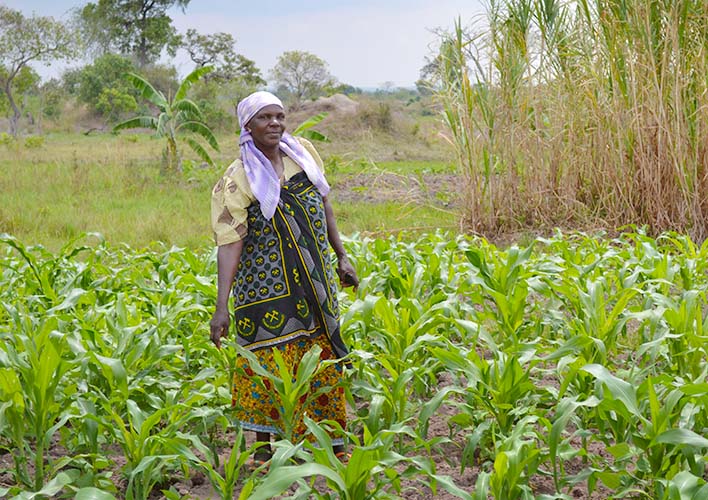Veronica Bukwimba stands in her farm in Mwanza, Tanzania. Bukwimba is receiving training in improving her crops through Foodgrains Bank member World Renew. (Photo: Naomi Johnson)
Women farmers among those most affected
Erratic weather patterns are making life more precarious for millions of people in our world’s poorest communities. Climate change continues to be a cause for the rising number of hungry people globally, threatening farming livelihoods, animal and plant life, water availability and entire food systems.
Yet, the impacts of climate change aren’t experienced equally. Women in developing countries, whose livelihoods are dependent on the land, are among those most vulnerable. When I met Veronica Bukwimba, a small-scale farmer in Tanzania, she could explain this to me all too well.
“The rains are increasingly unpredictable, making it extremely difficult to know when to plant,” she said. She also spoke of new pests that she had never before seen in her area.
As a female farmer and a mother of ten, Veronica is no stranger to hard work. She knows that as a woman, she spends more time on farm labour and caring for the family than her male neighbours. She also has fewer resources, access to information and decision-making ability that would enable her to flourish. Now, with increasingly unreliable rains, Veronica’s load is magnified, as she must carry water to irrigate her fields. Veronica is just one of the millions of people in developing countries who are already struggling to deal with significant changes in rainfall, storms and temperatures.
With access to enough resources, women like Veronica can not only adapt but thrive in the face of climate change. It is estimated that if women farmers had the same access to resources as men, the number of hungry people in the world could decrease by 150 million. In Veronica’s case, the Foodgrains Bank worked with its member World Renew and their local partner in Tanzania to train her in conversation agriculture—a farming method that improves soil health and allows crops to grow in variable conditions.
More support needed
The United Nations Environment Program estimates that US$140 to US$300 billion will be needed annually by 2030 just to help women like Veronica adapt to a changing climate, highlighting a growing gap in funding for climate adaptation.
The United Nations climate change conference happening in Madrid December 3-10, is a crucial opportunity to increase support for adaptation, which prioritizes women and those most vulnerable to climate change. As developed countries plan for a new 2020 finance goal, it’s important they commit to contributing their fair share. This includes at least 50 percent of finance dedicated to helping people adapt to the effects of climate change, and additional funds to go towards loss and damage in situations where it is too late to adapt.
To ensure climate finance supports the most vulnerable, it should be in addition to existing Canadian aid funds, so as not to take away from other important priorities. One way to achieve this is by providing adequate support to the Green Climate Fund, the Adaptation Fund, and the Gender Action Plan.
Through investments that support farmers, especially women, as they work to adapt to climate change, we can begin to address the growing issue of global inequality, help reduce hunger rates among families in developing countries, and enable women like Veronica to flourish.
